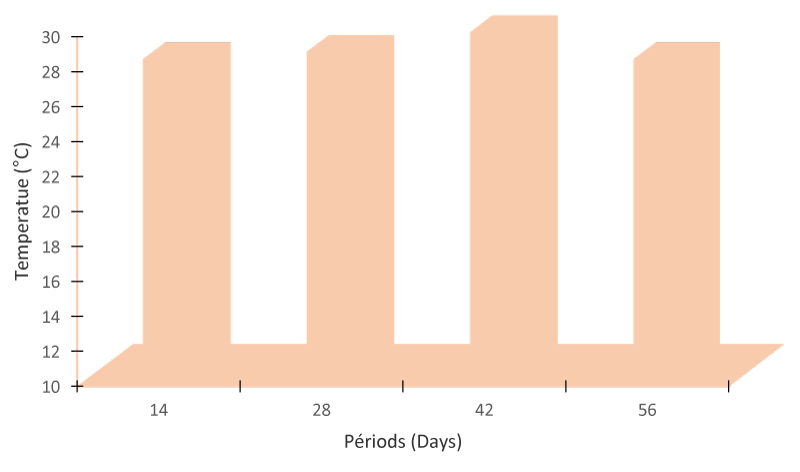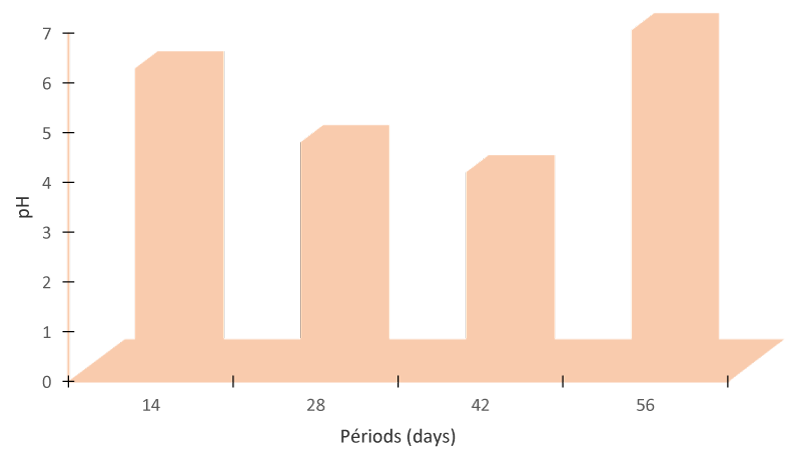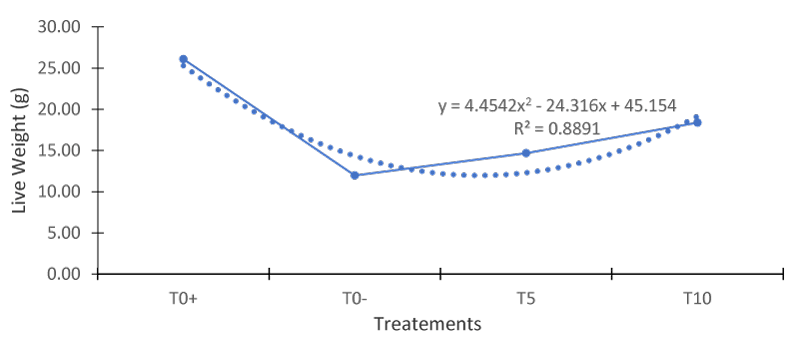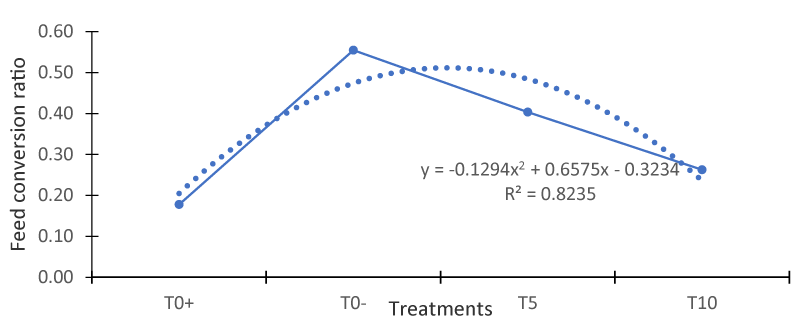International Journal of Aquaculture and Fishery Sciences
Effect of the replacement levels of soya bean meal by water Hyacinth flour (Eichhornia Crassipes) as a source of protein on the survival and some zootechnical performances of Clarias Gariepinus fry in concrete tanks
Zango Paul*, Ngouana Tadjong Ruben, Ngon Kong Suzanne and Tomedi Eyango Minette Tabi Abodo
Cite this as
Paul Z, Ruben NT, Suzanne NK, Tabi Abodo TEM (2022) Effect of the replacement levels of soya bean meal by water Hyacinth flour (Eichhornia Crassipes) as a source of protein on the survival and some zootechnical performances of Clarias Gariepinus fry in concrete tanks. Int J Aquac Fish Sci 8(4): 098-102. DOI: 10.17352/2455-8400.000084Copyright License
© 2022 Paul Z, et al. This is an open-access article distributed under the terms of the Creative Commons Attribution License, which permits unrestricted use, distribution, and reproduction in any medium, provided the original author and source are credited.In order to contribute to the increase of table fish production in the world in general and particularly in Cameroon through an optimal valorization of local by-products, the zootechnical performance of Clarias gariepinus fry was evaluated in concrete tanks according to the replacement levels of soya bean meal by water hyacinth flour (Eichhornia crassipes). For this purpose, a trial was conducted at the Logbaba Intensive Aquaculture Pilot Unit (LN: 4°02’ and 4°34’; LE: 9°41’ and 9°18’). A total of 240 Clarias gariepinus fry of initial mean weight 5 ± 0.22 g were divided into 12 batches of 20 fry each into 0.5 m3 baits in concrete tanks in a completely randomized device. These fries were fed for 56 days. The feed rations consisted of 4 iso-protein feeds with 47% protein. Either T0+ (positive proof) an imported food (Coppens), T0- (Negative proof) local food without soya bean meal and two other experimental foods whose soya bean meal has been replaced at 5% (T5) and 10% (T10) by Eichhornia crassipes flour. The results obtained showed that the highest survival rate (98.33% ± 2.88%) was recorded with the imported feed T0+ and lower (93.33% ± 2.76%) with the food containing 5% water hyacinth powder. The final mean weight and daily weight gain were significantly (P < 0.05) higher (26.08 ± 1.25 g and 1.49 ± 0.08 g/d respectively) with the T0+ diet and lower with the T1 local food (11, 92 ± 0, 90; 48 ± 0,06 g/d respectively). The average daily gain was comparable between the T5 and T10 diets (0.67 ± 0.14 g/d; 0.93 ± 0.12 g/d respectively). The specific growth rate (P < 0.05) and consumption index (P < 0.05) were significantly higher (2.87 % ± 0.08% g/d and 0.34 ± 0.04 respectively) compared to treatments containing 5% (T5) and 10% (T10) of water hyacinth powder (1.83 ± 0.24 g/d; 2.24 ± 0.17% g/d) and 1.08 ± 0.31; 0.66 ± 0.14) respectively. Thus, water hyacinth flour can be used to replace the soya bean meal as a protein source in the diet of Clarias gariepinus fry for optimal growth.
Introduction
World fisheries and aquaculture contribute decisively to the well-being and prosperity of inhabitants of the world [1]. However, high fishing activity and climate change, which are influencing the availability of biodiversity in the face of an ever-increasing demand for fishery products, suggest that aquaculture is the only alternative to meet the demand for animal proteins. Global aquaculture production reached a new record in 2018, with 114.5 million tons in live weight equivalent [2]. Despite efforts to improve aquaculture production, it remains very insufficient annually. To remedy this, it is imperative to promote the use of balanced diets based on non-conventional food resources that do not compete directly with human food [3,4]. Clarias gariepinus is a high-value-added fish in many African countries. In Africa, the high price of industrial feed formulated for fish is one of the main obstacles to the development of the aquaculture sector [5]. Therefore, reducing feed burdens and consequently reducing the total cost of production is one of aquaculture’s priorities. Concerted efforts have therefore been made to seek appropriate alternatives with regard to feed ingredients. This work has aimed to reduce production costs by minimizing the use of conventional feed ingredients such as fishmeal and soya bean meal, or even by replacing them altogether with other feeds. Water hyacinth (Eichhornia crassipes) is considered in several tropical and semi-tropical countries to be a harmful plant, as it disrupts river transport, irrigation, and aquatic ecosystems [6]. Looking at its biochemical composition, it is noticed that it contains nutrients of interest for the diet of fish. Indeed, it has all the vitamins and amino acids required for their growth [7]. In addition, water hyacinth contains on a dry basis between 12% and 35% protein [8] and contains a very low or almost non-existent level of anti-physiological factors (tannins) [8]. In 2020 water hyacinth has being used as a feed for Rohita labeo [9]. Similarly, many works have been done on the use of water hyacinth as food for Ciprinus Carpio [10,11]. Given the abundance of this plant and its nutritional interest, it seemed appropriate to look for a process to use this macrophyte for the production of animal proteins. It is in this light that we felt it was necessary to reduce the proportion of soya bean meal by substituting it in feed with water hyacinth flour in different proportions and to test the effectiveness of the formulas on the survival rate and some of the growth performance of Clarias gariepinus fry in pre-magnification.
Geographical location and duration of the trial
The Logbaba Intensive Aquaculture Pilot Unit (UPAIL), in Douala 3 Sub Division is located in the Wouri Division of the Littoral Region of Cameroon, between 4°02’ and 4°34’ North Latitude and 9°41’ and 9°18 East Longitude. The Douala 3 Sub Division is about an area of 115 km2 and at an altitude between 0 m and 60 m. The objective was to assess the effect of the level of replacement of soya bean meal by water hyacinth flour (Eichhornia crassipes) on the survival and growth of Clarias gariepinus fry in happa concrete tanks. This work lasted eight weeks between May and June 2021.
Experimental rations
For this purpose, four types of protein foods have been used, namely: T0+ (Coppens), T0- (local feed without water hyacinth) and two compounded feeds with two levels of substitution of soya bean meal by water hyacinth flour T0.05 (5% hyacinth flour) and T0.1 (10% hyacinth flour). Three feeds have been formulated using the numerical method with a target of 47% crude protein. One kilogram of each type of feed was made. The actual manufacture consisted of mixing the raw materials previously crushed in a basin with the addition of 1/3 of boiled water for 5 minutes. The resulting paste was transformed into granules using a granular with a diameter of 2 mm and dried in the sunshine for four days to prevent any further development of fungi Table 1.
Feeding
The feed was distributed to the fry twice a day: in the morning at 6:30 a.m., and in the evening at 6 p.m. and the rationing rate was 6.5% of their body weight for the first three weeks and 5% until the end of the experiment.
Physico-chemical parameters of water
The temperature and pH were recorded daily, before and after feeding the fish using a multi-parameter brand HANNA Hi 98135.
Experimental device and biological materials
In a concrete tank of 30 m3, a total of 240 fries from MOHAMED CENTER of medium 5.22 g ± 0.1 g was acclimatized before loading, at the rate of 20 fries per batch of four treatments in 0.5 m3 mesh baits arranged in triplicates.
Fifty kilograms of fresh weight of water hyacinth were taken from the fishing port of Douala. Its leaves were spread on a tarpaulin and were subjected to the thermal pressure of the sun in a greenhouse for two weeks until they became dry, they were crushed. Drying eliminated the water and possible thermolabile toxic factors present in the leaves.
Control fisheries
Control fishing was conducted every 14 days. Before each control fishery, the fry was left on an empty stomach the day before, in each batch of the different treatments, the sampling of fish was done at random in order to determine the measurements using a ruler graduated to the millimeter and the weight of each individual using a precision balance of one gram of sensitivity brand SF-400. The total number of fish was determined to estimate their survival rate. After the check, the fish were returned to the previously cleaned baits and the total biomass was calculated in order to adjust the daily rations.
Parameters studied
The data collected made it possible to calculate the following parameters:
- Survival rate (SR): It results in the following formula:
SR (%) = (Nf / Ni) x 100 where Ni: Initial number and Nf: Final number
- Average weight (AW)
AW= TW/n; TW = Total weight, n = number of individuals harvested
- Daily Weight Gain (DWG): It is evaluated as follows:
DWG (g) = (FMW–IMW) /t; where FMW=Final Mean Weight, IMW= Initial Mean Weight and t= Duration of study (days)
-Specific growth rate (SGR): It has been calculated as follows:
SGR (% g/d) = [ln (FMW) – ln (IMW)] x 100/t
-Consumption index (CI): It was calculated as follows:
CI = Amount of feed distributed/Body mass gain
Statistical analysis
The parameters studied were subjected to a one-factor analysis of variance (ANOVA 1). In case of significant differences, the means were separated by the Duncan test at a 5% significance level using the Statistical Package of Social Science version 20.0 (SPSS) software. The figures were plotted using a Microsoft Excel 2019 spreadsheet.
Results and discussion
Variation of some physico-chemical parameters of water.
A number of water quality parameters such as water temperature and pH were measured every 15 days during the study period.
Temperature variation
Temperature is one of the most important factors in water quality that influences the growth, food intake, reproduction, and other biological activities of aquatic organisms. During the study period and regardless of the study period, temperatures vary between 28 °C and 30 °C. The highest temperatures (29.53 °C ± 0.01 °C) were recorded at 42 days of age and the lowest (28 °C ± 0.09 °C) was recorded at the start of the test. No significant difference (p < 0.05) was found between treatments for mean water temperature values. These results are inferior to 27.95 °C - 31.05 °C in a carp polyculture pond [12]. In the contrast, it is comprised of between 26 °C and 32.44 °C on Labeo rohita in the pond [9-13] Figure 1.
pH variation
Figure 2 shows that the pH of the water ranged from 4.9 - 7.1. The highest pH was recorded at 56 days of age and the lowest significance (p < 0.05) was observed at 42 days. These observed values are less than 7.43 - 8.05 in a tilapia pond [10]. Nonetheless, it was comparable to 5.66 - 7.44 in the basin water [13]. In the same way not too lower than 7.10-7.43 was recorded in ponds [9]. This variation in pH could be explained by the differences in rearing environments.
Growth performance
Table 2 shows that whatever the period of study with the exception of the survival rate, the average weight, weight gain, specific growth rate, and consumption index were significantly affected by the incorporation of water hyacinth flour into the feed.
Survival rate
Table 2 shows that, regardless of the study period, the analysis of variance found no significant difference (p = 0.532) between treatments. However, the highest survival rate (98,38% ± 2.88%) was recorded with fry fed with Coppens feed (T0+) and the lowest rate (93.33 ± 5.76) with fry fed with T0.05 where soya bean meal was substituted at 5% by water hyacinth flour.
Average weight
The average weight varied significantly over the entire study period. However, the average weight of fry fed with copper (T0+) was significantly (p < 0.05) higher (26.08 g ± 1.25 g) compared to that of fry in T0-, T0.05 and T0.1 treatments where soya bean meal was substituted at 0%, 5% and 10% by water hyacinth flour.
In addition, fry fed with T0.1 (10% water hyacinth flour) feed recorded a significantly higher average weight (p < 0.05) (18.36 ± 1.76g) compared to rations T0- and T0.05 containing 0 and 5% water hyacinth. The lowest value (11.92 ± 0.90) was recorded significantly with the T0- hyacinth flour-free treatment. From Figure 3 we can observe that the incorporation of water hyacinth flour at increasing rates in the diets of Clarias gariepinus fry leads to a decrease in the weight of fish.
These results are contrary to studies conducted on Rohita labeo fry with an average weight of 4.0 g ± 0.14 g [9], common carp fry with an average weight of 1.64 g [14] and carp fry with 1.618 g ± 0.138 g [15]. These results were lower than 31.22 - 40.18 with the incorporation of up to 40% of water hyacinth flour [16].
The average daily gain
The average daily gain of fry fed with coppen feed (T0+) was significantly higher (p = 0.000) (1.49 ± 0.08 g/d) over the entire study period compared to that of fry in the T0-, T0,05, and T10 treatments where soya bean meal was substituted at 0%, 5% and 10% by water hyacinth flour. In addition, fry fed with T10 feed (10% water hyacinth flour) recorded a significantly higher average daily gain (p = 0.000) (0.93 ± 0.12 g/d) compared to T0- and T0.05 rations containing 0% and 5% water hyacinth. The lowest value (0.48 ± 0.06 g/d) was recorded significantly with T0- treatment.
These results are similar to the incorporation levels of 0% to 15% of water hyacinth flour in common carp fry [11]. No difference was found in the groups of fish fed with 0% and 20% incorporation into the diets of Roho labeo fry with an increasing level of raw water hyacinth leaf flour [9-14].
Specific growth rate
Over the entire period of the study, the specific growth rate was significantly higher (p < 0.05) (2.87% ± 0.08% g/d) with T0+ treatments (coppen feed) followed by T0.1 (10% water hyacinth) compared to the other two T0- (0% water hyacinth) and T0.05 (5% water hyacinth) which were also comparable. These results are different from those recorded with 0 to 30% water hyacinth flour incorporated in red tilapia and catfish (Clarias gariepinus) [17]. These results could be explained by the difference in species and the breeding environment.
Consumption index
The consumption index was significantly higher (p < 0.05) (1.23 ± 0.31) with T0- treatments (0% water hyacinth) followed by T0.05 (5% water hyacinth) compared to the other two T0+ (Coppens food) and T0.1 (10% water hyacinth) which were also comparable. Figure 4 shows that the incorporation of water hyacinth flour into the local feed of Clarias gariepinus fry leads to a sharp decrease in the consumption index with a regression coefficient close to 1 (R = 0.823). A growth rate from 0.84% - 0.54% g/d using 0% up to 40% water hyacinth in catfish feed (Clarias gariepinus) respectively was found [18]. In grass carp, the specific growth rate was 0.735 ± 0.022 when fed with a 15% water hyacinth diet [15]. Moreover, this specific growth rate was comparable with 0.95 - 1.1 with incorporation rates ranging from 0% to 15% of water hyacinth [9].
Conclusion
The incorporation of water hyacinth flour into fish feed as a feed ingredient can be used not only to reduce the cost of the fish feed but also to maintain its nutritious value. This study demonstrated that the feed with 10% water hyacinth flour generated the highest values of zootechnical characteristics. In addition, these test feeds have varying consumption indexes, although statistically not different; when these are lower than that of the commercial industrial feed on the market. The feeds developed in this study have the advantage of being locally available, relatively less expensive, and accessible to fish farmers, unlike commercial industrial feed. Utilization of locally available feed ingredients such as water hyacinth would reduce the cost of compounded feeds and feed preparation can be done on a small scale leading to job creation in the field.
Contributions of authors
The incorporation of water hyacinth flour into fish feed as a feed ingredient can be used not only to reduce the cost of the fish feed but also to maintain its nutritious value. This study demonstrated that the feed with 10% water hyacinth flour generated the highest values of zootechnical characteristics. In addition, these test feeds have varying consumption indexes, although statistically not different; when these are lower than that of the commercial industrial feed on the market. The feeds developed in this study have the advantage of being locally available, relatively less expensive, and accessible to fish farmers, unlike commercial industrial feed. Utilization of locally available feed ingredients such as water hyacinth would reduce the cost of compounded feeds and feed preparation can be done on a small scale leading to job creation in the field.
- FAO. Insectes comestibles : Perspectives pour la sécurité alimentaire et l’alimentation animale. Etude FAO forêts n° 171. Rome. 2014; 224.
- FAO. La situation mondiale des pêches et de l’aquaculture 2018. Avant-Propos.
- Tomedi EM. Status of fish farming in Cameroon Hilton Hotel in Yaoundé, March 31, 2015.
- Geoffroy F., Naves M., Saminadin G., Borel H. et Alexandre G. (1991) Use of unconventional feed resources by small ruminants. Review Elev Med Vet Country Too. (Special No.): 105-112.
- Dahouda M, Toléba SS, Senou M, Youssao AKI, Hambuckers A, Hornick JL. Les ressources alimentaires non-conventionnelles utilisables pour la production aviaire en Afrique: valeurs nutritionnelles et contraintes. Ann Méd Vét. 2009; 153:5-21.
- Hecht T. A review of on-farm feed management practices for North African catfish (Clarias gariepinus) in sub-Saharan Africa. In MR Hasan, MB New (Eds.), On-farm feeding and feed management in aquaculture. FAO Fisheries and Aquaculture Technical Paper No. 583. Rome, FAO. 2013;463-479.
- Gupta BS, Satapathy N, Chabbra SS, Ranjhan SK. Effect of various levels of Chakunda leaf meal on growth and egg production of White Leghorn birds. Indian Vet J. 1970 Dec;47(12):1094-101. PMID: 5499507.
- Liang JK, Lovell RT. Nutritional value of water hyacinth in channel catfish feeds. Hyacinth ControlJournal. 1971; 9: 40-44.
- Soliman AK. Water hyacinth proteins concentrate meal as a partial fish meal replacer in red tilapia diets. Animal and Fish Production Department, Faculty of Agriculture, University of Alexandria, Alexandria, Egypt. 1994.
- Md. Al-Amin Sarker*, Kamrun N, Hasna B, Turjaun N. Incorporation of Water Hyacinth, Eichhornia crassipes Meal in Aqua-feed and its Effi cacy on Growth Performance of roho labeo, Labeo rohita (Hamilton, 1822) Reared in Cagev. 2020; 46-48.
- Shaha DC, Devnath S, Roy NS, Dewan S. Determination of suitable monoculture technique for GIFT in the northern region of Bangladesh. Bangladesh Journal of Fish. 2003; 26: 67-72.
- Mohapatra SB, Patra AK. Utilization of Water Hyacinth (Eichhornia crasipes) Meal as Partial Replacement for Fish meal on the Growth Performance of Cyprinus carpio fry. Int Res J Biological Sci. 2013; 2: 85-89. https://bit.ly/2M5hV6Z
- Bhuiyan MIA, Hossain MA, Ehsan MA, Hasan MR. Effect of different supplementary feeding methods on growth of fi sh in carp polyculyure. Depertment of Aquaculture, BAU. Bangladesh J Fish. 2002; 25: 161-171.
- DoF. National Fish Week Compendium 2008, Department of Fisheries, Ministry of Fisheries and Livestock, Government of the People’s Republic of Bangladesh.160.
- Saha S, Ray AK. Evaluation of Nutritive Value of Water Hyacinth (Eichhornia crassipes) Leaf Meal in Compound Diets for Rohu, Labeo rohita (Hamilton, 1822) Fingerlings after Fermentation with Two Bacterial Strains Isolated from Fish Gut. Turkish Journal of Fisheries and Aquatic Sciences. 2011; 11: 199-207. Link: https://bit.ly/2AbQh5C
- Mahmood S, Khan N, Iqbal KJ, Ashraf M, Khalique A. Evaluation of water hyacinth (Eichhornia crassipes) supplemented feed on the growth, digestibility and histology of grass carp (Ctenopharyngodon idella) fingerlings. Journal of Applied Animal Research. 2018; 46: 24-28. Link: https://bit.ly/3c7Lore.
- Sadique JK, Pandey A, Khairnar SO, Kumar NBT. Effect of molassesfermented water hyacinth feed on growth and body composition of common carp, Cyprinus carpio. Journal of Entomology and zoology. 2018; 6: 1161-1165. Link: https://bit.ly/3gCaDFU
- Hontiveros GJS, Tumbokon BLM, Serrano AE. Protein concentrate of water hyacinth partially replaces soya bean meal in the diet of the Nile tilapia Oreochromis niloticus juveniles. Animal Biology & Animal Husbandry International Journal of the Biofl ux Society. 2015; 7: 60-66. Link: https://bit.ly/36y6gHf
- Konyeme JE, Sogbesan AO, Ugwumba AAA. Nutritive value and utilization of water hyacinth (Eichhornia crassipes) meal as plant protein supplement in the diet of Clarias gariepinus. 2006.

Article Alerts
Subscribe to our articles alerts and stay tuned.
 This work is licensed under a Creative Commons Attribution 4.0 International License.
This work is licensed under a Creative Commons Attribution 4.0 International License.





 Save to Mendeley
Save to Mendeley
